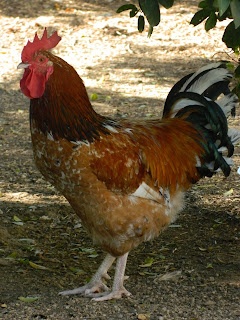Marketed as the "German Uber-Chicken" the Bielefelder chickens have sold very well here in the USA, with Greenfire selling newborn females for $29 and males for $19 each, currently, as baby chicks. They are supposedly terrific for both food and eggs. Since I'm looking to make Alohas good dual-purpose farm chickens, these traits are exactly what I need in Alohas as well.
One rooster is a mix between Bielefelder and Rhode Island Red. What is good about that, for my program, is I know through tests that the red color picks up spots with no problem. (Unlike solid buff with buff tail chickens which would not show spots no matter how hard I tried.)
The other rooster is - most likely - half Aloha! How about that?
I put them in with a few hens with color that I love, but these girls really need a boost in size:
Now, the funny thing is, I've been avoiding Barred chickens, because I know that a Barred rooster can turn the whole flock Barred in one generation! So it's not like I hate the color when Mottling is added, it's pretty, but it can "take over" a flock quickly, and soon that is the only color you will get, if you aren't careful.
I recently learned more about "auto sexing" breeds, however, and I think I know how to use these boys in the program effectively. I will keep only the barred girls, who may or may not also have spots - it depends on which boy is the daddy, and whether he really is half Aloha and carries spotting? Most likely the chicks will be solid red and barred, just like the Dads.
However, I have learned that if I keep only the Barred hens from this cross, and breed them to a rooster with no barring - let's say a Speckled Sussex rooster for example - the hens will not have barring, and the boys will all have barring. At birth, the boys will have a light spot on the top of the heads and the girls will not. In other words, if I keep the hens of this cross and pair them with the right boy, I could be able to sex the chicks at birth, and raise ONLY the hens!
Every hen from this next generation would have a 50/50 chance of being spotted if paired with a spotted Aloha rooster. The result of that cross would be 1/4 Bielefelder hens, with spots.
The Bielefelder carries the gene for yellow legs, which makes them a great choice for pairing with the Aloha / Sussex crosses, to try and add the yellow leg gene. The hens from this cross could go GREAT with roosters from "Big Orange Roo" or spotted sons from the Dun pen.
The size of these half Bielefelder boys? HUGE. I took my "Big Orange Rooster" over to their pen, to compare size. I thought my Big Orange guy was big, but not compared to these new dudes. These half Bielefelder boys are still at least two inches taller, and also carry more weight!
 |
| This guy has some serious drumsticks. |
I have only three breeder pens right now, which makes it difficult to work on all the projects that I need. This was an unexpected diversion. Eggs are sitting on my counter right now ready to go in the incubator. Hopefully, we'll see how the chicks look in a few weeks?
 |
| The Bielefelder breeder pen, February 2016. |






































